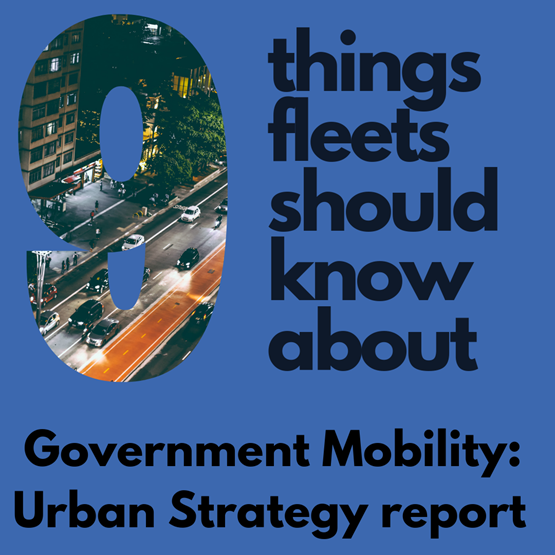This editorial feature appears in the May 30, 2019 issue of Fleet News and is sponsored by The AA and Goodyear.
The Government has released its Future of Mobility: Urban Strategy report, which sets out the nine principles which will guide its approach to emerging mobility technologies and services, as well as help define its vision of urban transport.

Andrew Ryan looks at the principles and their meaning:
Read the sponsor's comment provided by Stuart Thomas, director of fleet and SME at The AA

Principle 1: New modes of transport and new mobility services must be safe and secure by design
Department for Transport says: People’s safety and security will be our number one priority in our approach to emerging mobility innovation. New vehicles, services and infrastructure should not increase the risk of harm to transport users and other citizens. What is the potential impact?
Numerous surveys have found that safety tops the list of people’s concerns about self-driving vehicles, which means the industry faces a challenge to ensure people are comfortable with handing over control, says Lukas Neckermann, managing director of Neckermann Strategic Advisors.
“That means we need to prioritise safety above all else,” he adds.
“Whether the autonomous vehicle has to be five times, eight times or 10 times safer than a human at the wheel, we do know that in order to convince people of the potential of autonomous vehicles, they need to deliver on the promise of not just reduced incidents but approaching zero incidents.”
Multiple studies have found that more than 90% of road collisions are caused by human error and suggestions that autonomous technology could completely eradicate incidents have been described as “untested and uncertain hypothesis” by the International Transport Forum (ITF).
“Some people say that if we have automation we can get rid of 90% of the accidents, but I don’t believe that,” adds Christoph Lauterwasser, managing director of Allianz Centre for Technology.
“Especially in the beginning, when we will have mixed traffic, we will see accidents and it is very important we learn from those accidents.”
The ITF adds that many crashes involving human error also involved other factors which may still have led to the collision, even if the human had not committed an error in judgement or perception.
These could include poor roadway design or faulty vehicles, while human error “can also be non-driver-related errors by pedestrians, cyclists and motorcyclists”.
It adds: “Since they won’t be automated, the errors will probably not be eliminated by automation.
"These contributions do not likely impact the general finding that automation may continue to significantly better safety outcomes, but it may temper the assessment of automation benefits versus disbenefits.”
Principle 2: The benefits of innovation in mobility must be available to all parts of the UK and all segments of society
Department for Transport says: Access to transport is vital to individual freedom and well-being, social cohesion and a productive economy. Mobility innovation offers huge opportunities to address disparities in access to travel, tackle loneliness and achieve a more inclusive society.
What is the potential impact? The mobility strategy makes it clear that both Government and business must consider the needs of all when developing transport services and policy – including elderly and disabled people and those less well off.
It includes ensuring that new services increase rather than decrease the options available to people in areas with poor public transport links, and making sure that people without the internet, a smartphone or bank account still have a good transport offer available.
New mobility services and technologies should be accessible and inclusive by design, while the trend towards ride-sharing will need to cater for users of wheelchairs and mobility scooters, as well as those who, due to mental health or developmental conditions, might not feel comfortable sharing with strangers.
The challenges facing future mobility are vast and different for urban and rural areas. For example, London faces an ageing population, a growing population (8.9 million now; 10m by 2030), inequality – 27% of people are living in poverty while 10,000 have houses worth more than £10m – and an activity crisis.
These changes have to be solved by the transport service to prevent stifling growth opportunities.
Rural areas face different challenges to towns and cities.
Ralph Smyth, former head of infrastructure and legal at the Campaign to Protect Rural England and now a transport consultant, says a point the report misses is “the challenge of the transition between urban and rural”.
He adds: “Urban local authorities are trying to get people to use cars less. Meanwhile, in rural areas buses are being cut. What do you do if you live in the country and you want to go into the city, but have an old polluting car?
“For the car-free city dweller, how do you get out into the country?”
Principle 3: New mobility services must lead the transition to zero emissions
Department for Transport says: The zero emission transition is essential to meeting our climate change targets and improving air quality, particularly in urban areas.
The technology already exists to make it happen. New transport modes and business models, such as self-driving vehicles and ride-hailing services, must be in the vanguard of this change, leading it and not holding it back.
What is the potential impact? The Government wants to see new cars and vans delivering as many zero emission miles as possible as quickly as possible.
It wants at least 50%, and as many as 70%, of new car sales to be ultra low emission by 2030, as well as up to 40% of new van sales.
“Improvements in battery technology are coming in at 10%, 15%, 20% year-on-year,” adds Lukas Neckermann.
“That’s something the internal combustion simply cannot keep up with. At best, we can improve the diesel and petrol engine 2% or 3% year-on-year.
“We are getting to the point where the electric vehicle is quite simply the cheaper and most certainly the better option for fleets, for cities, for air quality and frankly also for the automobile industry.
“It’s where the potential lies, it’s where the growth lies.”
Principle 4: Mass transit must remain fundamental to an efficient transport system
Department for Transport says: Many journeys into and around crowded urban areas, over distances too long to walk and cycle, are always going to be best served by high capacity mass transit.
What is the potential impact? Irrespective of changes in technology, individual motorised transport will never be able to match high capacity transport for getting people in and around dense urban centres and meeting increased demand on the network.
In Nottingham, for example, the provision of two new tramlines paid for by the city’s workplace parking levy (WPL) increased the number of people using public transport.
This saw a modal shift with 20% of people who used their cars moving instead to trams.
“The two new tramlines are now carrying 20 million passengers a year,” says Nigel Hallam, WPL service manager at Nottingham City Council.
The Government wants new mobility services to complement rather than compete with mass transit, for example, by making it easier to get to and from major transport hubs.
It also wants public transport operators to consider how new technologies and business models can help them to improve the reliability, responsiveness, accessibility, affordability and safety of their services.
Principle 5: Mobility innovation must help to reduce congestion through more efficient use of limited road space, for example through sharing rides, increasing occupancy or consolidating freight
Department for Transport says: There is finite road and pavement space in our towns and cities, many of which were laid out long before the advent of motorised transport.
The lower running costs enabled by new technologies and business models could worsen congestion if vehicle occupancy and load factors remain low.
What is the potential impact? Exploratory analysis into the effects of self-driving vehicles on congestion has indicated the effects are highly dependent on how far ride-sharing is adopted.
Analysis by the Department for Transport suggested that traffic could grow 55% between 2015 and 2050 if ride-sharing fails to take off and vehicle occupancy decreases from an average of 1.5 people to 1.3.
This growth in traffic could increase to 71% if self-driving vehicles also widen access to mobility and carry passengers.
If ride-sharing becomes embedded and average vehicle occupancy increases from 1.5 to 1.7 people, growth in road traffic could be 5%.
Principle 6: Walking, cycling and active travel must remain the best options for short urban journeys
Department for Transport says: The greater the share of journeys taken by walking and cycling in urban areas, the better the air quality and health outcomes and the lower the congestion.
This will always be true irrespective of developments in automation, electrification and new ways of travelling.
What is the potential impact? The National Travel Survey (2017) found that, in England, 45% of all journeys taken by urban residents are less than two miles.
For many people, these trips could be easily undertaken by sustainable, active modes of transport, such as walking and cycling, which support local economies and have huge benefits for health.
Studies have found regular cycling to work is associated with a 45% lower risk of developing cancer and a 46% lower risk of developing heart disease, compared with commuting by car or public transport.
In the west of England, Travelwest (funded by local authorities) provides information and resources to businesses and residents on sustainable travel.
It runs an electric bike leasing scheme for business use.
One of the participating companies is RSK/Structural Soils, and Eric Downey, its senior engineering geologist, says: “Our e-bike started to earn its keep when a colleague undertook a local site audit by bike rather than take a vehicle.”
Principle 7: The marketplace for mobility must be open, to stimulate innovation and give the best deal to consumers
Department for Transport says: A competitive, open marketplace for mobility is needed to increase consumer choice, drive innovation and lower prices.
What is the potential impact? Digitally-enabled mobility services could make travel easier and more convenient as consumers are able to plan journeys integrated across different modes of transport using travel apps.
However, the report says, to realise the benefits most fully, the UK needs to avoid a fragmented market, or one in which one or two large companies have excessive market power.
Principle 8: New mobility services must be designed to operate as part of an integrated transport system combining public, private and multiple modes for transport users
Department for Transport says: It is often not possible to get where you want to go using a single public transport option. Increased use of data and new technology can help join up different modes, timetables, ticketing and payment across new and existing transport services.
What is the potential impact? Business models such as Mobility as a Service (MaaS) have the potential to make the planning and execution of multimodal journeys easier, moving people away from the private car and towards sustainable transport options.
In theory, this could reduce congestion, improve air quality through decreased vehicle use, and improve users’ health by encouraging increased use of active modes of travel such as walking and cycling.
In October last year, for example, Fleetondemand launched its MaaS app for business, Mobilleo, following three years of research, development and testing.
The company says the app integrates thousands of public and private transportation providers into a single, configurable platform.
It allows users to find, book and pay for their entire business journey (including parking, car hire, flights, trains, accommodation, restaurants, airport lounges, car clubs, buses and taxis, in one transaction.
Principle 9: Data from new mobility services must be shared, where appropriate, to improve choice and the operation of the transport system
Department for Transport says: Increased data sharing is vital to ensuring an open mobility marketplace, enabling a better user experience and improving the safety and efficiency of the transport network.
What is the potential impact? As new privately-run transport services become increasingly important in the transport system of today and tomorrow, they need to play their part in sharing data in a way that maintains individual privacy, says the report.
This will help to ensure a competitive market, integrate journeys across different modes and improve local authorities’ ability to understand and manage the transport network.
Further work will be needed to determine which datasets should be shared and with who, to strike the right balance between empowering local authorities and consumers, and being fair to those who have invested in collecting and formatting data.
 A suite of mandatory new vehicle safety equipment has been agreed for new type approval models from 2022, and for all existing models by 2024.
A suite of mandatory new vehicle safety equipment has been agreed for new type approval models from 2022, and for all existing models by 2024.
EU policymakers expect this to dramatically reduce fatalities, cut traffic collisions by 30% and potentially save up to 25,000 lives over 15 years.
The proposed Bill features compulsory inclusion of intelligent speed assistance (ISA) systems and data loggers. Advanced driver assistance systems (ADAS), such as autonomous emergency braking (AEB), lane-keep assist, driver fatigue detection and reversing camera or sensors will also be mandatory.
The introduction of compulsory ADAS is a key step towards fully autonomous vehicles, an issue that formed a key part of our 2018 Operational Fleet Report, created in partnership with BT Fleet.
Of the fleet managers surveyed, just 29% said they would expect autonomous vehicles to be used in operational fleets within five years.
Meanwhile, 67% believed autonomous vehicles would represent a threat to fleet management, with job losses for drivers topping the list of concerns.
However, almost two-thirds agreed that autonomous vehicles would offer safety benefits as well as a reputational effect of being seen as innovative – while fleet managers felt autonomous vehicles will roll out with certainty, once practical considerations have been addressed.
At The AA, we welcome any technology that will make UK roads safer. We would encourage the Government to continue the existing dialogue around autonomous vehicles in fleets, while fleet managers continue to bring forward matters arising from technology development, ongoing trials and legislation.
- Visit theaa.com/business for more information.





















Login to comment
Comments
No comments have been made yet.